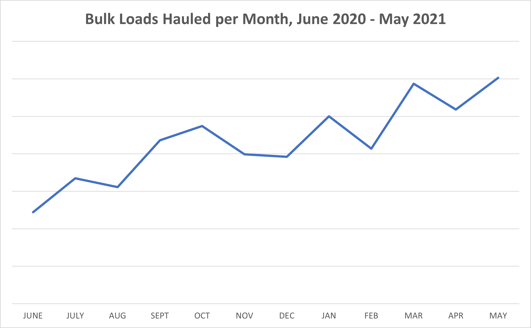In the first four months of 2021, bulk freight shippers have seen tight capacity and high rates for bulk trucking services. Both of those trends have continued in May and show no signs of letting up as we head into summer. In this article, we’ll examine the current bulk freight landscape as well as one of the main causes of tight capacity: the driver shortage.
The current bulk freight landscape
 The economy continues to bounce back from the COVID-19 pandemic and bulk shippers are moving product as quickly as possible. The inset graph shows the volume of bulk freight loads handled by Bulk Connection between June 2020 and May 2021.
The economy continues to bounce back from the COVID-19 pandemic and bulk shippers are moving product as quickly as possible. The inset graph shows the volume of bulk freight loads handled by Bulk Connection between June 2020 and May 2021.
This is a very healthy increase in shipping activity over the past year. In fact, there have been 164% more loads shipped through Bulk Connection in May 2021 than there were in May 2020. The problem? There are many more loads out there waiting to be shipped. There just isn’t enough capacity to handle them.
New driver shortage data
The driver shortage is one of the leading causes – if not the leading cause – of this tight capacity market. There are simply more loads than there are drivers to haul them.
A recent Bulk Transporter article contains new statistics which show just how challenging this driver shortage is for the bulk freight industry. According to the procurement intelligence company, Beroe, Inc., “there are approximately 63,000 vacant truck-driving jobs in the bulk tanker market today, and the global tanker trucks market is predicted to need 174,000 new truckers by 2026.” The article goes on to say that the shortage is particularly bad in the U.S. Midwest.
In addition to capacity constraints, the driver shortage is also one of the leading causes of the high rates that carriers are charging for bulk freight services. Because drivers are so scarce, there is great competition for the services of drivers that are available. Large carriers are only able to attract drivers with significantly higher wages (as opposed to even a year ago) and attractive benefits packages. Small- to mid-size carriers have little choice but to offer the same, thereby driving up their own costs substantially – and leading to higher rates for shippers.
To learn more about the driver shortage and ways of dealing with the current capacity crunch, stay tuned to the Bulk Connection blog for the latest bulk freight insights. And, for more information on how we can help you get your freight in motion, contact Bulk Connection today.



